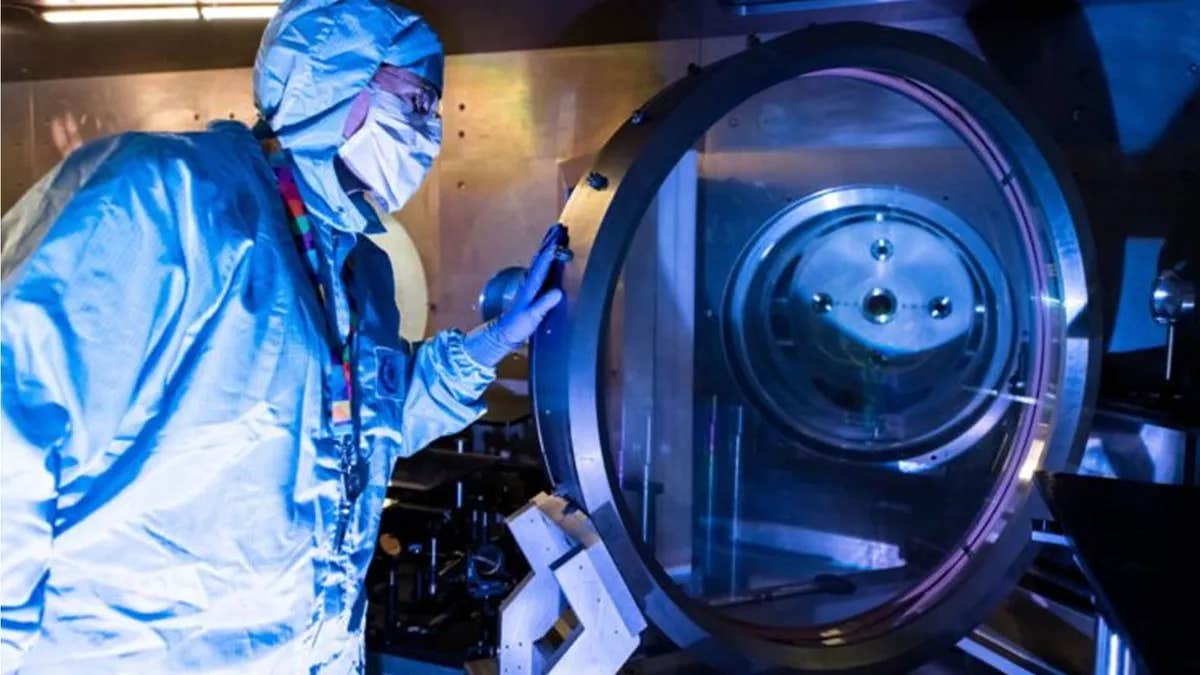Revolutionary new lasers are 1,000x more powerful than current ones
Could revolutionize the next generation of lasers, enabling their power to exceed current capabilities by over one million times.

[Dec. 24, 2023: JJ Shavit, The Brighter Side of News]
These groundbreaking new laser pulses are more than 1,000 times more potent than any currently in existence. (CREDIT: UKRI)
In a groundbreaking collaboration between scientists from the United Kingdom and South Korea, a new method for generating laser pulses of unprecedented power has been unveiled. These laser pulses are more than 1,000 times more potent than any currently in existence.
The research, published in the prestigious journal Nature Photonics, demonstrates a novel approach to compressing light, significantly increasing its intensity. This development has the potential to not only extract particles from the vacuum but also revolutionize the next generation of lasers, enabling their power to exceed current capabilities by over one million times.
The research, conducted jointly by teams from the University of Strathclyde, Ulsan National Institute of Science and Technology (UNIST), and the Gwangju Institute of Science and Technology (GIST), centers around the creation of a specialized mirror. Unlike traditional mirrors that merely reflect light, this unique mirror possesses the remarkable ability to compress light pulses in time, achieving a compression factor of more than 200 times, with the potential for further refinement.
The laser pulse compressor based on a density gradient plasma, in which a long-duration, high-energy, negatively frequency-chirped laser pulse reflects from an over-dense plasma slab with an increasing density ramp. High-frequency components at the front of the pulse and low frequency components at the rear part of the pulse reflect at different positions, leading to compression of the laser pulse. (CREDIT: Nature Photonics)
The concept behind this innovation relies on the gradient in the density of plasma, which consists of fully ionized matter. The scientists have harnessed this property to cause photons to "bunch up" similar to the way a group of cars on a steep hill will naturally bunch together. This approach promises to unlock a new era in laser technology, where powers could surge by more than a million times compared to current capabilities.
Power Beyond Imagination
Currently, the world's most powerful lasers boast peak powers of approximately 10 petawatts, equivalent to 10^15 watts. To put this in perspective, consider that the sun radiates an astonishing 4x10^26 watts of power, or 400,000 zettawatts (10^21 watts). High-power lasers are known for producing incredibly short pulses of light, typically lasting only a few femtoseconds (10^-15 seconds). Achieving such ultrashort durations relies on chirped pulse amplification (CPA), a technique that compresses laser pulse energy into an extremely brief period, thus amplifying its peak power exponentially.
Incident pulse (red) and stroboscopic view of the reflected pulse (green to blue). On the plasma density profile (grey shade), nh and nl are the critical densities for ωh (the highest frequency at the front tip of the pulse) and ωl (the lowest frequency at the rear tip of the pulse), respectively. (CREDIT: Nature Photonics)
Professor Dino Jaroszynski, from the University of Strathclyde's Department of Physics, highlighted the significance of high-power lasers, stating, "An important and fundamental question is what happens when light intensities exceed levels that are common on earth. High-power lasers allow scientists to answer basic questions on the nature of matter and the vacuum and explore what is known as the intensity frontier."
A Gateway to New Possibilities
Furthermore, the application of terawatt to petawatt lasers has facilitated the development of next-generation laser-plasma accelerators, which are thousands of times smaller than conventional accelerators. This advancement is poised to provide scientists with powerful new tools, fundamentally transforming the landscape of scientific research. The Scottish Centre for the Application of Plasma-based Accelerator (SCAPA), established at the University of Strathclyde, represents a concerted effort to drive applications based on high-power lasers forward.
Related Stories
Professor Min Sip Hur, of UNIST, emphasized the wide-ranging applications of this research, stating, "The results of this research are expected to be applicable in various fields, including advanced theoretical physics and astrophysics. It can also be used in laser fusion research to help address the energy issues facing humanity. Our combined Korean and UK teams plan to experimentally test the ideas in the lab."
One of the pivotal elements of this research is the role of plasma, which can be likened to traditional diffraction gratings used in CPA systems but with one crucial advantage—it is impervious to damage. Professor Hyyong Suk, of GIST, explained, "Plasma can perform a role similar to traditional diffraction gratings in CPA systems but is a material that cannot be damaged. It will therefore enhance traditional CPA technology by including a very simple add-on." Furthermore, Professor Suk pointed out, "Even with plasma of a few centimeters in size, it can be used for lasers with peak powers exceeding an exawatt."
Harnessing the Power of Compression
While exawatts and zettawatts may seem like unimaginable levels of power, the principle behind increasing laser intensity is surprisingly straightforward. By focusing a laser pulse onto a small spot using a lens or curved mirror, the energy within the pulse can be concentrated to an extraordinary degree.
a–e, Growth of RBS of the incident pulse in a thermal plasma (Te = 10 eV) (a–c) and compressed pulse after reflection (d,e). f–j. Pulse compression under the same condition as a–e but with a quarter-cut plasma. k,l, Compressed pulse profile in time (k) and spectra of the incident (l), the compressed pulse and the RBS signal for a full parabolic density. The pulse duration represents the FWHM of intensity (square of the field). m,n. Pulse profile and spectra for the quarter-cut plasma. (CREDIT: Nature Photonics)
This process, analogous to compressing a laser pulse in time, can also be applied spatially—compressing the pulse into a small spot. This spatial compression significantly enhances the intensity of the laser pulse. As a simple demonstration, focusing sunlight onto a piece of paper using a lens will result in the spontaneous combustion of the paper due to the increased intensity.
Pushing the Boundaries of Physics
As the intensity of laser pulses increases, matter undergoes remarkable transformations. For instance, air becomes ionized at intensities ranging from 10^10 to 10^12 W/cm^2 for visible light wavelengths. When subjected to laser intensities exceeding 10^18 W/cm^2, electrons approach the speed of light, ushering in the realm of relativistic optics.
a, Intensity of the compressed pulse versus the incident intensity for 0 and 10 eV, and full-quadratic and quarter-cut plasma. b, Ratio of the compressed pulse energy to the incident pulse energy. U/U0 = 1 corresponds to no energy loss during compression. (CREDIT: Nature Photonics)
At even higher intensities, around 10^24 W/cm^2 and above, protons approach the speed of light, and particles immersed in such intense laser fields react to their own radiation fields. This realm marks the current intensity frontier in physics. However, the most awe-inspiring threshold is the Schwinger limit, at intensities exceeding 10^29 W/cm^2. At this astonishing level, particles are generated directly from the vacuum itself, effectively transforming light into matter. Achieving such extraordinary intensity levels demands the deployment of exawatt to zettawatt lasers.
Unveiling the Mysteries of Matter and Vacuum
The quest to comprehend the nature of matter and vacuum at intensities surpassing 10^24 W/cm^2 stands as one of the most profound challenges in contemporary physics. High-power lasers not only enable this exploration but also offer a glimpse into astrophysical phenomena within the confines of a laboratory. These lasers provide unique opportunities to delve into the inner workings of stars and uncover the mysteries surrounding the origins of the universe.
This research promises not only to expand our understanding of fundamental physics but also to address pressing challenges, including laser fusion and clean energy production. As scientists continue to explore the intensity frontier, the potential for discoveries that could reshape our world and our understanding of the cosmos is limitless.
The research has been conducted with support from the National Research Foundation of Korea, UNIST Grad. School of Semiconductor Materials and Devices Engineering/HRD Program for Industrial Innovation, and the UK’s EPSRC (Engineering and Physical Sciences Research Council), which is part of UKRI.
Note: Materials provided above by Optica. Content may be edited for style and length.
Like these kind of feel good stories? Get the Brighter Side of News' newsletter.
Joseph Shavit
Head Science News Writer | Communicating Innovation & Discovery
Based in Los Angeles, Joseph Shavit is an accomplished science journalist, head science news writer and co-founder at The Brighter Side of News, where he translates cutting-edge discoveries into compelling stories for a broad audience. With a strong background spanning science, business, product management, media leadership, and entrepreneurship, Joseph brings a unique perspective to science communication. His expertise allows him to uncover the intersection of technological advancements and market potential, shedding light on how groundbreaking research evolves into transformative products and industries.



